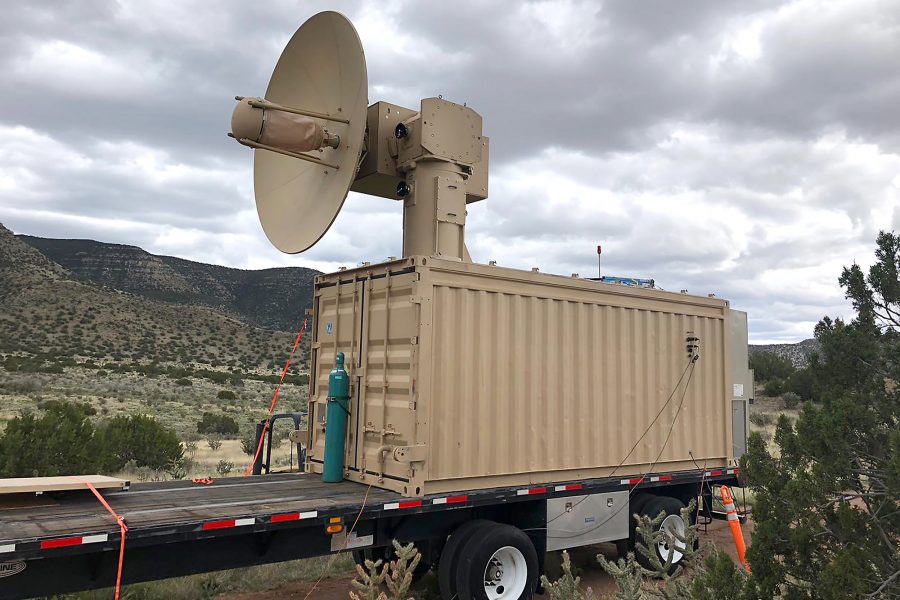DAYTON, Ohio—While the Pentagon continues to experiment with technologies that could disable or destroy swarms of small drones, the Air Force’s lead on counter-drone acquisition said more funding is needed to counter the threat—and to turn promising efforts into programs of record.
The counter-small unmanned aerial systems mission, or C-sUAS, is one that Steven Wert, program executive officer for the digital directorate, has been tracking for several years now.
The Pentagon started ramping up spending on counter-drone weaponry around fiscal 2018, spending hundreds of millions of dollars on the effort. Around the same time, experts began warning that small, relatively cheap armed drones could bombard bases and wreak outsized havoc—making them attractive to a whole range of adversaries from China and Russia to Iran and even non-state actors, such as violent extremist groups.
“In response to urgent operational need, we fielded gear at many of our most critical bases,” Wert said at the Life Cycle Industry Days conference July 31. “But we never got developmental funding to modernize that gear, which is now five or six years old, probably seven- or eight-year-old technology.” Nor did the Air Force fully “explore different phenomenologies in the counter-UAS space.”
Meanwhile, the threat of small drones has only grown, highlighted by their use in Russia’s invasion of Ukraine and Ukraine’s subsequent response.
“I have repeatedly said I’m concerned about the lack of funding there given the increasing number of incursions that we see around the world,” Wert said. “That situation has not really changed. [Today] it is at the point where labs are developing different capabilities, but we don’t have the ability to catch those into a production program.”
For the Air Force, the Tactical High-power Operational Responder, or THOR—a short-range directed energy weapon developed by the Air Force Research Laboratory—is the most high-profile example this kind of capability. THOR uses microwaves to interfere with drones’ electronics, dropping them from the sky. First unveiled in 2019, the system has had a long path to development. Earlier this year THOR successfully disabled a swarm of drones, the first test on such a scale.
AFRL said it was developing a follow-on system in 2021, calling it “Mjolnir” for the hammer wielded by the Norse god Thor. In 2022, the lab selected Leidos to build the system, saying it would employ the same technology as THOR “but will add important advances in capability, reliability, and manufacturing readiness.” AFRL said it hoped to have a prototype by 2023, but has offered no updates since.
Meanwhile, other technologies have been explored—AFRL tested both microwave and laser weapons in overseas demonstrations but has offered few details on their effectiveness.
The Army is also developing solutions. The Pentagon established an Army-led Joint C-sUAS office in 2020, and it has since held four demonstrations, most recently in July. It has worked on both directed energy and kinetic weapons to take on single-drone attacks as well as swarms.
The joint C-sUAS office issued a request for white papers on Aug. 4, seeking “potential materiel solutions that have promising technologies or approaches” for detecting, tracking, identifying, and/or defeating small drone swarms. The most promising responses will be selected for further analysis, the request said, and some may be invited to participate in the office’s next demonstration, planned for June 2024.
In a separate request for information, the joint office said the demonstration will consist of “no less than 20 but up to 50 individual aircraft (Group 1 and Group 2) at one time and no less than six Group 3 aircraft at one time.” Group 1 and 2 aircraft refer to drones that weigh 55 pounds or less and normally only fly a few thousand feet above the ground. Group 3 includes drones that weigh less than 1,320 pounds and fly no higher than 18,000 feet.
The joint office’s request for white papers notes that after the demonstration, some companies may be selected for a prototyping program and even follow-on production without competition.

